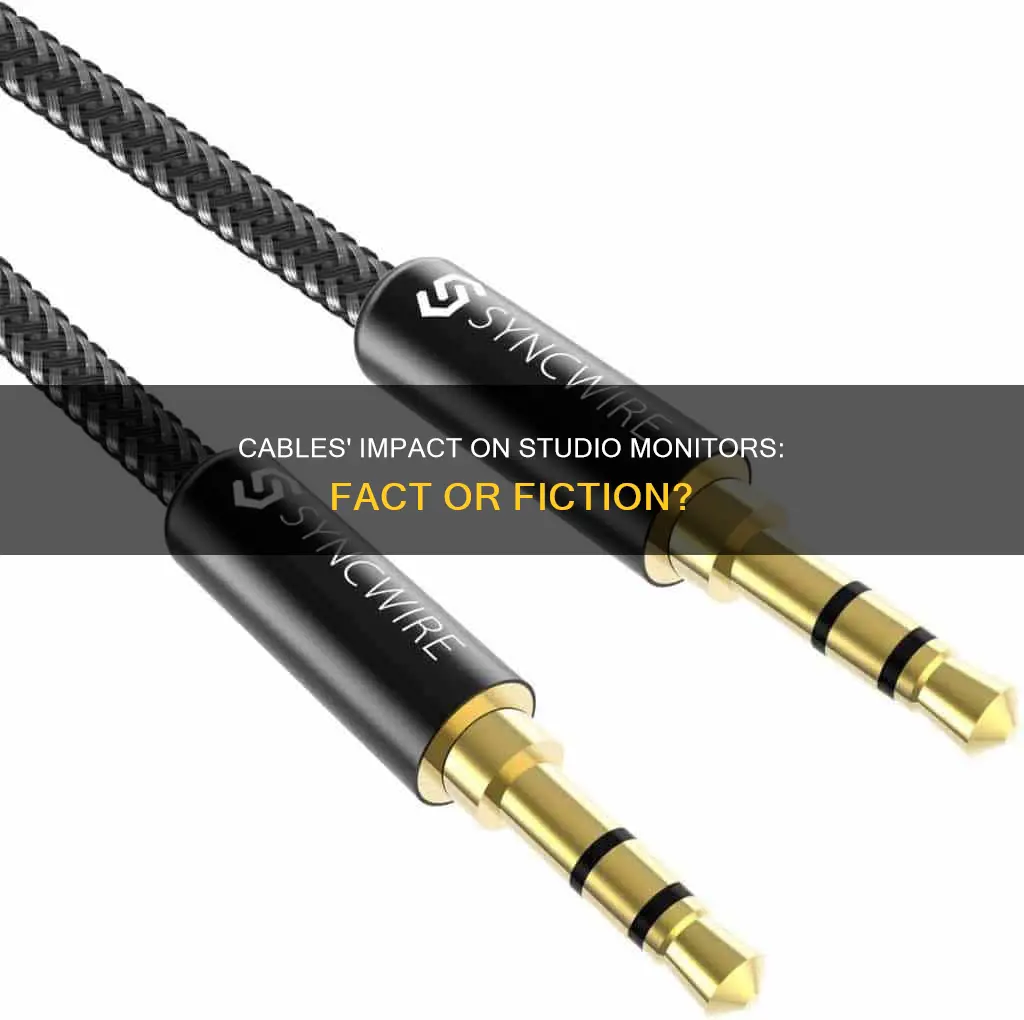
Studio monitors are important tools for recording engineers and audio enthusiasts. They provide accurate feedback during recording, and they are also essential for mixing and mastering. However, connecting monitors can be confusing for beginners because they have different inputs and outputs, and specific cables are required for each purpose.
Studio monitors typically have analog connections like XLR and jack connections, but some have digital connections. Analog cables deliver audio signals through an electrical current, which can sometimes cause noise and interference. Digital cables, on the other hand, send audio signals via binary code, eliminating the possibility of interference from electrical currents or other devices.
Balanced cables, such as XLR and TRS jack cables, are recommended as they reduce or eliminate noise and interference. XLR cables, in particular, are considered the best type of analog cable for studio monitors, as they can run up to 100 feet without any issues. TRS jack cables come in two types: TS (Tip-Sleeve), which is unbalanced and used for instruments; and TRS (Tip-Ring-Sleeve), which is balanced and used for stereo.
When choosing cables for studio monitors, it's important to consider the type of connectors, budget, and whether to use balanced or unbalanced cables. The length of the cables is also a factor, as longer cables can generate signal noise and affect syncing. Additionally, active studio monitors usually require a 3-pin power cable, while certain studio monitors may also need RCA cables, auxiliary cables, optical digital cables, or speaker wire.
| Characteristics | Values |
|---|---|
| Cable type | XLR, TRS, TS, RCA, optical digital, speaker wire |
| Cable function | Power, audio input/output |
| Connection type | Balanced, unbalanced |
| Cable length | Varies, longer cables may generate more signal noise |
| Cable thickness | Varies, thinner cables may affect performance |
What You'll Learn

Balanced vs. Unbalanced Cables
The choice between balanced and unbalanced cables for your studio monitors can have a significant impact on the sound quality and your overall listening experience. Here's a detailed comparison to help you decide which type of cable is best suited for your needs:
Balanced Cables
Balanced cables are designed to deliver a clear and interference-free sound. They achieve this by using a clever technique called "phase cancellation". Balanced cables have two signal wires, known as the "hot" and "cold" wires, which carry the same audio signal but with opposite polarities. When the signals reach the end of the cable, the "cold" signal is flipped and combined with the "hot" signal. Any noise interference that was picked up by the cable is cancelled out in this process, resulting in a clean and noise-free audio signal.
Balanced cables are the preferred option for studio monitors as they effectively eliminate unwanted noise and buzzing sounds. They are also generally better quality and more reliable, making them ideal for longer cable lengths. Additionally, balanced cables are commonly used in professional audio equipment and are suitable for running audio signals over long distances.
Unbalanced Cables
Unbalanced cables, on the other hand, consist of a single conductor or signal wire and a ground wire. Unlike balanced cables, they do not have the same noise-cancelling capabilities. While they can work well for shorter connections, such as connecting a guitar to a nearby amplifier, they become more susceptible to interference over longer distances. The ground wire in an unbalanced cable can act as an antenna, picking up unwanted noise and causing interference in the audio signal.
Unbalanced cables are more prone to picking up electrical and radio interferences, especially from power cables and older lighting equipment. To minimise interference when using unbalanced cables, it is important to be careful with cable placement and keep them as short as possible.
Making the Choice
When deciding between balanced and unbalanced cables for your studio monitors, consider the following:
- Check your studio monitor inputs and your audio interface outputs. If they support balanced cables, it is recommended to use them to reduce interference and improve sound quality.
- If you are experiencing buzzing or humming noises with your current setup, switching to balanced cables can help eliminate these issues.
- For longer cable runs or when cables are surrounded by a high amount of electric signals, balanced cables are the better choice.
- If you are working in a smaller studio environment and don't require long cable lengths, unbalanced cables can be a more cost-effective option.
- Balanced cables tend to be priced higher due to their more complex design and better noise-cancelling capabilities.
Monitoring Security Performance: Methods and Record-Keeping
You may want to see also

TRS vs. XLR Cables
When it comes to studio monitors, the cables you use can make a difference in sound quality and functionality. TRS and XLR cables are both balanced cables, meaning they have the same electrical properties and offer the same level of noise reduction. The main difference between the two is the shape of the connector. TRS cables use a tip-ring-sleeve design, while XLR cables have a locking connector.
TRS cables are commonly used for studio monitor connections and are often more affordable than XLR cables. They are available in various lengths, ranging from 3 feet to 25 feet, and can be used for other connections besides studio monitors. TRS cables are typically used for patching connections between monitors and interfaces, and they can also be used for connecting other hardware.
On the other hand, XLR cables are known for their ruggedness and are often preferred by professionals in live sound or film work. XLR cables are less likely to be accidentally unplugged due to their locking connector. They are available in lengths up to 20 feet and can also be used for connecting microphones and DMX lighting.
In terms of sound quality, both TRS and XLR cables can provide clear and faithful sound reproduction without introducing interference. However, some users report experiencing less fuzziness and distortion when using XLR cables, especially over long distances. This may be due to the third prong on XLR cables, which provides additional grounding.
Ultimately, the choice between TRS and XLR cables depends on your specific needs and preferences. Both options are viable for studio monitor connections, and the main factors to consider are the compatibility of your equipment, the length of cable needed, and your budget.
VA's CPAP Monitoring: How It Works and Why
You may want to see also

Power Cables
The power cables that come with studio monitors are usually sufficient, but there are instances where you might want to consider an upgrade. For example, if you require longer cables to reach your desired setup, you can find power cables in lengths of up to 50 feet. Thicker gauge wiring, such as 16AWG, can also help reduce noise and improve performance.
When choosing power cables, it's important to prioritize safety. Always ensure that your power cables are in good condition and that your connections are secure. Proper cable management will not only enhance the performance of your studio monitors but also reduce the risk of electrical hazards.
While power cables may seem like a basic component, they play a critical role in ensuring the functionality and performance of your studio monitors. By selecting the right cables and maintaining them properly, you can achieve reliable and uninterrupted operation.
Hatchbacks with Blind Spot Monitoring: Which Cars Have This Feature?
You may want to see also

Analog vs. Digital Cables
When it comes to studio monitors, the cables you use can indeed make a difference in sound quality. However, the difference may lie more in the type of cable (analog vs. digital, balanced vs. unbalanced) rather than the price. Here is a comparison between analog and digital cables:
Analog Cables
Analog cables are the standard for studio monitors and are widely used in professional studios. They are preferred for several reasons:
- Clean Signal Path: Analog cables provide a direct connection between the source and the studio monitors, avoiding any additional digital processing that could alter the signal.
- Modularity: With analog cables, you can choose your preferred DACs (digital-to-analog converters) and ADCs (analog-to-digital converters), allowing you to tailor the sound to your specific needs.
- Zero-Latency Monitoring: Analog cables, particularly XLR connections, offer zero-latency monitoring, which is crucial when recording with microphones.
- Compatibility: Most studio monitors and audio interfaces have analog inputs and outputs, making analog cables compatible with a wide range of equipment.
- Maintenance: Analog cables and separate amplifiers make maintenance and replacement easier, as you can swap out individual components without affecting the entire system.
- Cost: Analog cables tend to be more affordable than their digital counterparts, especially when it comes to high-quality options.
Digital Cables
Digital cables have their own advantages and could be a viable option depending on your setup:
- Reduced Signal Conversion: By using digital inputs and outputs, you eliminate one extra signal conversion (DAC) in the chain, potentially improving sound quality.
- Convenience: Digital connections can be more convenient, especially if you are already using digital equipment, as they reduce the number of cables and connections needed.
- Wireless Potential: While not widely adopted yet, wireless digital connections could offer a cable-free setup, removing the need for physical cables altogether.
In conclusion, both analog and digital cables have their advantages. Analog cables are the industry standard due to their compatibility, flexibility in equipment choices, and clean signal path. However, digital cables can provide benefits such as reduced signal conversion and potential wireless connectivity. Ultimately, the right choice depends on your specific needs, equipment, and personal preferences.
Monitor Your MacBook's CPU Usage: A Step-by-Step Guide
You may want to see also

Cable Length
When it comes to studio monitor cables, length is an important consideration. While longer cables offer the flexibility of increased distance between your equipment, they also come with potential drawbacks that can affect audio quality and performance.
Firstly, it's important to understand that longer cables can introduce signal noise and interference issues. This is because the longer a cable is, the more opportunity it has to pick up electrical interference from other devices or power sources. This interference can degrade the audio signal, resulting in unwanted noise or a reduction in sound quality. Balanced cables, such as XLR and TRS, are designed to reduce noise and interference, and are therefore recommended to mitigate this issue.
Additionally, longer cables can cause a slight delay in the audio signal. While this delay may be negligible for shorter cables, it becomes more noticeable as the cable length increases. This can affect the syncing of audio, particularly if you are working with multiple audio sources or require precise timing.
To minimise these potential issues, it is generally recommended to use the shortest cable length that meets your distance requirements. If longer cables are necessary, it is advisable to invest in higher-quality cables that are designed to minimise interference and maintain signal integrity.
When purchasing cables, it is also worth considering cable management solutions, such as cable ties or labels, to ensure that longer cables remain organised and don't pose a tripping hazard in your studio space.
Blind Spot Monitoring: Which Honda Accords Have This Feature?
You may want to see also
Frequently asked questions
There are a variety of cables available for studio monitors, including power cables, XLR cables, TRS jack cables, RCA cables, auxiliary cables, optical digital cables, and speaker wire.
No, the cables you need depend on the specific studio monitors you have and how you want to connect them. You will always need power cables and input/output cables.
Balanced cables are designed to reduce or remove noise and interference. The most common types are XLR and TRS jack cables. Unbalanced cables, such as TS jack cables, are more prone to noise and interference.
Not necessarily. While more expensive cables may have better build quality and durability, even cheap cables can work just as well as long as they are the correct type for your setup.







